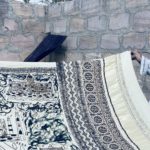The amazing ajrakh block printing
Ever since fabric was invented, humans have tried various methods of decorating the plain woven fabric. Embroidery was one technique. Ajrakh and Bandhini were others. All three are visible in Kutch. All of them begin with yarn. Dyeing this yarn is an important next step. If India is considered a land of colour, it perhaps is because we dye our clothes into vibrant colours.
Humans have used dyes made from plants and minerals for millennia. Evidence found in the Indus Valley site of Mohenjodaro shows the existence of dyeing even back then. Cave paintings found all over the world show that humans figured out how to create dyes from plants such as indigo, marine fauna such as sea shells, and roots such as turmeric– that they then used to paint walls in the caves and later used to dye their clothes.
Ajrakh is one of the crafts that relied on these natural dyes. Beginning with textiles traded in the Arab world, Ajrakh made its way through Southeast Asia and the Indian Ocean to Sindh and then Gujarat.
So what is the fuss about Ajrakh?
The process of creating and Ajrakh fabric can take up to 4 weeks to complete. This technically complex craft requires 10 to 16 different stages of resist and mordant printing, followed by dyeing and finishing.
These videos give you a sense of what goes into Ajrakh block printing.




